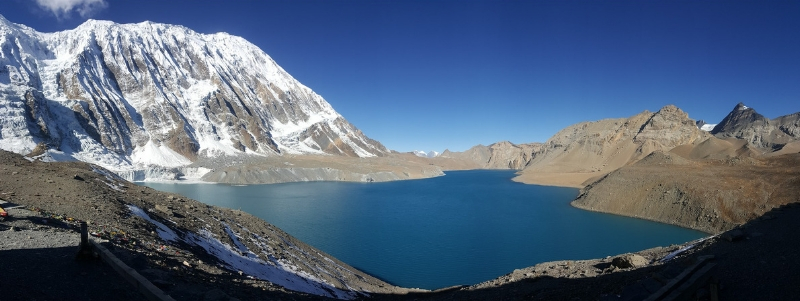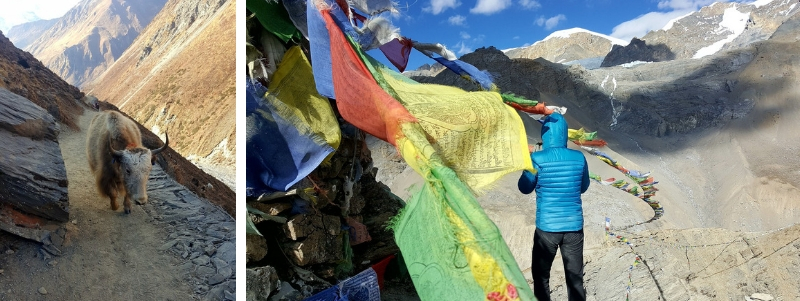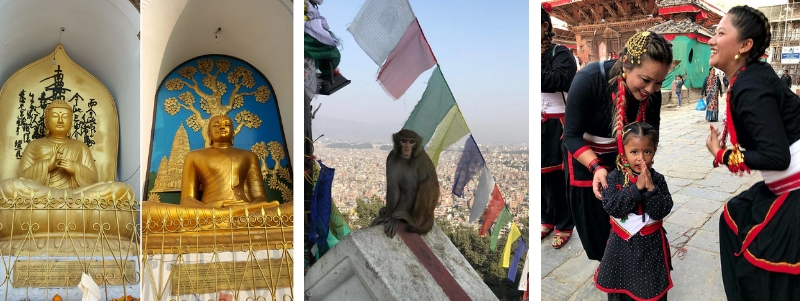Tour leader Cristina Taioli shares stories of her travels to Nepal
Exactly a year ago I was in the Danakil desert in Ethiopia, one of the hottest, driest places on earth. This year I decided to go in the opposite direction to the freezing temperatures of Nepal’s Himalayan mountains.
This would be my first trip to Nepal, and I wanted to do some hiking that would be vastly different from the hills and forests near my home in Italy. It was hard to decide on one of the many available treks in Nepal, but after some communication with a tour operator from Kathmandu I finally decided to hike the Annapurna Circuit.
The Annapurna Circuit encircles the Annapurna Massif, a mountain range in central Nepal, and it also includes a detour to the highest lake on earth, Tilicho Lake, sitting at 4920 meters (16141 ft). The trek also reaches the highest pass, Thorong La pass, at 5416 meters (17769ft), touching the edge of the Tibetan plateau.
Because I like surprises, I did not ask many questions about the trek. I knew it was 14 days long, and felt confident that years of cycling would leave me reasonably well-trained for the physical demands of the hike. My only real concern was the altitude. Even when I go skiing in the Italian Dolomites I never reach an altitude of 5000 meters (over 16000 ft), and acute mountain sickness (AMS), was a reality I wanted to be prepared for. (Fortunately I never had to take the “Diamox”-tablets preventing AMS, but I did share them with less fortunate people who I met along the way.)
Trekkers hike the route counterclockwise, as it’s easier and safer for the body to acclimatize. My 3-person group spent 2 weeks trekking on varied terrain. We hiked from 4 to 9 hours daily, about 10 to 29 km per day (6 to 18 mi) for a total of 200 kilometers (125 mi).
Every morning my alarm went off at 6:30 a.m, and, after a filling breakfast, I rubbed my feet with Vaseline before putting on my socks and boots. I would then grab my walking sticks, put my backpack on, and hit the trail. Twice we had to start walking at 5:30 a.m., in order to experience the sunrise from a summit: The first time before reaching the highest lake on our route and the second while on the highest pass in the world.
Along the way I slept in “tea houses”. These buildings are not heated, except for a wood stove in the dining room that warms the place during dinner. But there was no warm water for a shower, or warm bedroom when I went to sleep. Thankfully, the beautiful scenery made me forget my fatigue, and the cold nights I spent in my thermal underwear inside my sleeping bag – or the torture of getting out of it in the morning to use the outdoor toilet, which was just a hole in the ground.
Wood is very important in these mountains as it is the only way for the people to warm up. Nobody in Nepal lives in a heated house, including the big cities like Katmandhu, Pokhara and Chitwan, so basically people are used to being in the cold environment, and always keep a jacket on, outdoor and indoor.
It was unthinkable to take a shower or wash my hair at temperatures as low as -10C° (14F), so I spent my two weeks dirty and smelly – even the yaks kept their distance from me!
The only thing that warmed me up during the day was the local tea,”chai masala,”with lemon or ginger, and other spices. I drank this often, including at lunch and dinner. You could consider my new new taste for Nepalese tea a bit unusual for a coffee addict such as myself. After all, I am Italian!
The views along the way were amazing. At such altitude the colors of the mountain peaks around me, lit by the rising sun, was unforgettable.
My legs were tired even though I did not have to carry my big backpack. My porter did a wonderful job, carrying up to 25kg (55lbs) of weight, distributed among his head, shoulders and hips. This is the law of the mountain: men and animals have to carry up all the necessary things, since there is no road, and no cars can come up here, which make the food and drink up to two or three times more expensive along the route than down in the valley.
At the end of my trek there was a very nice surprise: the hot springs of Tatopani.
During the day I had the sun and the physical exercise to increase my body temperature, but once I arrived at each night’s destination, my muscles had to put up with the cold temperatures, therefore they were stiff and contracted most of the time. Submerging my body in this hot spring felt like a heavenly way to end to such a stunning trek!
The local inhabitants are mountaineers, tough men living in a very cold and harsh environment, with snow, ice, strong wind, and a pitch-black world around them during nighttime. Here only the essentials are available and must be hiked all the way up on their shoulders, or on the backs of their animals: donkeys, mules, yaks, horses.
It was a life lesson for me, if I think of all the things I take for granted at home. On the Annapurna Circuit I lived two weeks without heating, hot water, wifi, smartphone, television, but instead was happy with the essentials – nice company, beautiful places, fresh air, and warm food.
I was proud of myself for making it that high, and I thanked my grandma Angelina, who always watches over me from heaven.
Lots of prayer flags surrounded me on the mountains peaks, around monasteries, along the trails: long lines of Buddhist prayers in 5 different colors representing the 5 elements in a human life: blue for the sky and the space, white for the air and the wind, red for the fire, green for the water and yellow for the earth.
During my steps I’ve spun the Mani wheels hundreds of times, always repeating the Buddhist mantra : “Om Mani Padme Hum”
Back to the Kathmandu Valley
Nepal is divided into two different parts: the Himalaya in the north of the country, with 8 of the 14 mountains over 8.000 meters (over 26000 ft) high, and the flat land in the south. About 29 million people live in the country. The majority of the population is found in the 3 rich cities: Kathmandu, Pokhara and Chitwan.
When I arrived in Pokhara, famous for the beautiful lake Pewa Tal I was looking at my big room. It was warm inside, the water in the shower was hot, the bed was comfy, I was as happy as a little kid with gelato! Finally I was able to get out of my hiking gear and back into my normal style, or I should say “Italian style”.
The indigenous inhabitants of the Kathmandu Valley are called “Newari”. A perfect example of their historic houses can be admired in Bandipur, a hill village, surrounded by mountains on one side, and terraces of rice fields on the other.
From here, like from other villages on the hills, you can see a wonderful sunrise or sunset over the Himalayan mountains covered in snow; many photos were taken, from different angles and at different times trying to capture the changes in colors, but the photos are nothing compared to what my eyes saw.
Chitwan is the first national park in Nepal, located a bit south of the country’s center. The temperatures here are much warmer and get up to 25C° (77F). Today the park is a World Heritage Site, renowned for its protection of the One-Horned Rhinoceros, the Royal Bengal Tiger and the Gharial Crocodile, thanks to very successful anti-poaching patrols, and a crocodile breeding center.
In addition to the tigers which are very hard to spot, you can see a lot of other animals. I took a jeep into the rain forest for 4 hours on a safari but chose not to ride elephants trained for tourists because I found the mahout’s training methods too cruel for my comfort.
Kathmandu with its 3 million people is the 7th most polluted city in the world. It is no wonder why almost everyone wears a breathing mask. Between the dust and the cars, the air is unbreathable, especially after 2 weeks spent in the mountains!
The city traffic is horrendous! There is a never-ending flow of cars, buses, motorbikes, bikes. And cows, since they are sacred animals and considered Shiva transport. Pedestrians have to meticulously time their road crossings if they don’t want to get run over by a moving vehicle because the rule in Kathmandu is to never stop for any reason. You have to confidently keep on moving through the traffic, as otherwise, if you stop in the middle of the road, drivers won’t know what to do and you can get hit!
If you ever go trekking in Nepal, you should dedicate a few days to the Kathmandu Valley. Here you’ll find UNESCO Heritage Sites, ancient city squares, local markets, a giant stupa with Buddha eyes, and temples of different shapes and sizes, full of monkeys, bells, and yak butter candles. You can attend the ceremony of the cremation of the dead, along the banks of the Bagmati, considered a sacred river.
It was very sad for all of us tourists visiting Nepal to still see the damage done by the latest earthquake on 25th of April 2015. A 7.8 magnitude earthquake had caused the death of over 8.000 people and destroyed many temples, stupa, houses, and palaces.
The reconstruction process is slow and difficult. They use local workers and local tools exclusively. In my opinion it will take forever to restore all the monuments to the way they looked before the earthquake. They best way we can support the reconstruction efforts is with our financial contributions. For example by buying a 15$ ticket to visit Durbar Square, which is the generic name used to describe the area in front of the old Royal Palace of the former Kathmandu Kingdom, with fountains, temples and open courts.
Another option is to take a private flight to go see Mount Everest and the Himalayan mountain range. I enjoyed this amazing experience in the cockpit with the pilots, and believe me, it was quite a show!
Something I noticed is that Hindus and Buddhists live together in a very smooth relationship. Eighty percent of the population in Nepal is Hindu and only 15% is Buddhist, but you can still find a Buddhist pagoda or a stupa and an Hindu temple in the same square or next to each other.
The food in Nepal is a cultural mix of Nepalese, Indian, Tibetan and Chinese cuisines. I loved the Tibetan “momo”: dumplings with different fillings and different sauces. You will never go hungry in Nepal with the many offerings such as fried or boiled rice and noodles, soups, meat, fish, various vegetables, always with a touch of garlic and chili. For those with a sweet tooth there is a variety of sweet cakes, and “lassi”, a delicious yogurt drink made with cow’s and buffalo milk, topped with cashew nuts and mixed dried fruit. When I was trekking in the mountains I had yak meat and some water buffalo meat in the valley. I like to try and discover new tastes – as long as the food is not too spicy, which is a real risk here!
Nepalese people are most faithful to their local dish, “dal bhat” which is served in a big round metal plate with a pile of rice in the middle and surrounded by many bowls filled with lentil soup, curry chicken, potatoes, green chili, pumpkins, spinach and chard: you can tell they like their veggies here!
Food is good in Nepal and so are the local beers. I probably tried all of them: Sherpa, Nepal Ice, Everest and Gorka.
I will forever be grateful to my Nepalese friend, Basu Panday, Team Leader of “Nepal Social Treks & Expedition”. Without him, my adventure in Nepal would not have been possible! He had the excellent idea to take me around Kathmandu on his motorcycle, a 500cc “Royal Enfield”. The zigzagging ride in that kind of traffic, the lack of a passenger helmet, and taking a roundabout the wrong way felt like suicide to me! But I lived to tell the stories.
Hopefully you’ve enjoyed these tales of my travels in Nepal – stay tuned for the next adventure!
Ciao,
Your Tour Leader Cristina
See more pictures from Cristina’s trip here!





